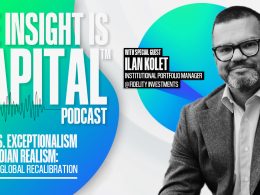This is a guest contribution by David Rosenberg, Chief Market Economist, Gluskin Sheff.
WHILE YOU WERE SLEEPING
The risk trade is intact with bonds selling off fractionally (the Treasury market is bracing for $104 billion of new supply this week), commodities holding onto their recent hefty gains and the equity market globally in the green column (save for Japan, China and Korea, which were down marginally).
The earnings news overnight from Europe looks to be solid and helping bolster investor optimism (in 3D no less – Daimler, Deutsche Bank, Danone; UBS beat as well though SAP did miss). German consumer confidence (GfK survey) rose unexpectedly in July (to the grand total of a two-month high!). Against this background, European bourses are riding a six-day winning streak.
In the FX market, safe-havens such as the Swiss franc and the Yen are softer; the DXY has also broken decisively below the 100-day moving average and the 50-day is now rolling over. How the tide has changed. It looks like the real kicker in this latest runup in the equity market was the raised guidance out of UPS and Fedex, which has supported the view that the expansion in global trade flows was not derailed by the recent debt flare-up in Europe.
In another sign that risk-tolerance is back, the high-yield market (which we like) has generated a total return (in the U.S.A.) of 3% so far this month and there are still three days to go (retail inflows into high-yield funds have totalled $2 billion in the past two weeks)! Credit default swaps on the largest global banks have receded to their lowest level in 12 weeks to boot; overall corporate default risks are being repriced to 10-week lows as well. Emerging market bond spreads have tightened to 279 bps from 359 bps at the end of May – and are still 50 bps wider compared to the mid-April lows.
And there has been a sustained narrowing in Club Med bond spreads too (Spanish spreads tightened 11 bps to 129 bps.). This is despite the fact that the stress tests did not really deal with the major challenge, which is a sovereign debt default and if one thinks the odds of such an event are trivial, then it may pay to look into the future at the massive amount of refinancings these countries confront in the next few years (in a word, daunting). Calm has been restored, at least for now. With the equity short-long ratio down to a two-year low (the market is really overbought here) according to Data Explorers, it will be interesting to see how much more upside there is now that the bears have gone back into hibernation.
Let's remind ourselves that the U.S. economy is still operating with a need to have jobless benefits extended for 99 weeks. This would make seasonal workers in Newfoundland blush. Here we are with a near-10% deficit/GDP ratio and a debt/GDP ratio a year away from hitting 100% – talk about a game-changer. Both the FT and the WSJ run with articles today highlighting the debate in the economics community over the effectiveness of U.S. fiscal policy.
What an indictment. This is an economy hanging on by tenterhooks because the Fed was supposed to have enough confidence in the economy to begin to stand on its own two feet so that the central bank's pregnant balance sheet was supposed to have been in the unwinding phase by now. Instead, the Fed has pledged to do even more quantitative easing, if warranted by the circumstances. And both newspapers also discuss today the continued fiscal crunch in the State & Local government sector, which represents 13% of GDP or double the share of business capital spending.
MARKET COMMENT ... WE'RE ALL CHARTISTS NOW
We’re 142 trading days into the year – 52 days (37%) have seen 1% or greater moves. And the S&P 500 is now flat as a beaver’s tail on the year. I call this the meat-grinder market. Again, a huge rally into yesterday’s close – and now the S&P 500 is sitting right at the 200-day moving average. This is starting to get interesting. Again, the lack of ratification from Mr. Bond as the 10-year note yield came back and closed the day a smidgen below 3%.












